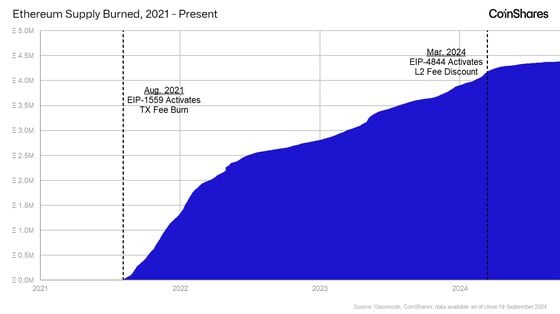
Ethereum’s ability to host a wide-range of applications and assets has been evident for years, but the investment case for its native token, ETH, has become increasingly complex. In the wake of key protocol changes, particularly the hardforks activating EIP-1559 and EIP-4844, investors are asking how Ethereum’s adoption will translate into ETH’s long-term value.
While the platform has scaled, the relationship between its growth and ETH’s supply and demand — and thus its price — is no longer as straightforward as it once seemed.
You're reading Crypto Long & Short, our weekly newsletter featuring insights, news and analysis for the professional investor. Sign up here to get it in your inbox every Wednesday.
When Ethereum implemented EIP-1559 in 2021, it introduced a burn mechanism where the overwhelming majority of transaction fees (base fees) would be permanently removed from circulation. This created a direct relationship between Ethereum usage and ETH’s supply. As users paid for transactions on the Ethereum network, the burn would act as a deflationary force, reducing ETH’s supply and putting upwards pressure on its price.
In 2023, our valuation model at CoinShares showed that under the right conditions, where Ethereum generated $10 billion annually in L1 transaction fees, something it achieved at its 2021 heights, ETH could reach a value near $8,000 by 2028.
Since then, however, optimism has waned due to the Dencun hardfork and the rise of Layer-2s (L2), which have upended the fee burn and altered ETH’s value potential.
L2 platforms were designed to scale Ethereum by moving transactions off the main chain (L1) and onto faster, cheaper networks. Initially, L2s complemented L1, helping the network handle more transactions without clogging the base chain — like a pressure release valve giving balance in times of high usage.

But with the introduction of “blob space” in 2024, L2s could now settle transactions on L1 at much lower costs, reducing their requirement to pay expensive L1 fees. As more activity migrated to L2s, the supply burn that EIP-1559 was designed to instill began to drop, weakening the downward pressure on ETH’s supply.
The reality of Ethereum generating high L1 fees to support ETH’s value is now looking bleak. L1 transaction fees have steadily collapsed, leading to questions about what differentiates the services offered at each layer, and what will drive the L1 fee landscape moving forward.
Despite these challenges, there are potential paths forward to restore demand for L1 transactions and, in turn, ETH valuation.
One option is developing high-value use cases that rely on L1’s security and reliability, yet, given current trends, this appears unlikely in the near future. Another possibility is that L2 adoption grows so rapidly that the sheer volume of transactions compensates for the discounted fees — but this would require extraordinary L2 growth, beyond near-term expectations.
The most likely, and perhaps the most controversial, solution is repricing blob space to increase L2 settlement fees. While this would restore some of the L1 supply burn, it risks upsetting the economics of L2s that have been key to Ethereum’s recent success and enhanced its ability to compete as an ecosystem with alternative platforms (like Solana, Binance Chain, etc.).
While L2s have scaled Ethereum, they have also disoriented the mechanisms that tie ETH’s value to its utility. For investors, this means that ETH’s future depends on how Ethereum balances innovation with maintaining healthy economic policy.
For now, ETH’s investment case is unsettling, and risks remain high as the Ethereum community decides its path forward.
Note: The views expressed in this column are those of the author and do not necessarily reflect those of CoinDesk, Inc. or its owners and affiliates.
免责声明:本文章仅代表作者个人观点,不代表本平台的立场和观点。本文章仅供信息分享,不构成对任何人的任何投资建议。用户与作者之间的任何争议,与本平台无关。如网页中刊载的文章或图片涉及侵权,请提供相关的权利证明和身份证明发送邮件到support@aicoin.com,本平台相关工作人员将会进行核查。




